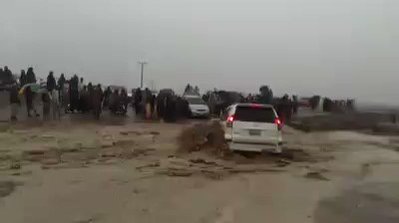
Devastating Video is Harsh Reminder to Please Heed Flood Warnings
A devastating video is being shared on Twitter today. Some claimed it was filmed in Inhambane, Mozambique, Thursday morning where the worst effects of Cyclone Dineo were felt. It was actually filmed in Chaman, Pakistan, during heavy rains in the region last month, January 2017. The video – showing a motorist caught in a surge of water and […]

A devastating video is being shared on Twitter today. Some claimed it was filmed in Inhambane, Mozambique, Thursday morning where the worst effects of Cyclone Dineo were felt. It was actually filmed in Chaman, Pakistan, during heavy rains in the region last month, January 2017.
The video – showing a motorist caught in a surge of water and unable to escape – presents a harsh reminder that when the South African authorities warn that citizens should not attempt to cross flooded roads, it’s deadly serious.
This morning the SA Government issued a warning to South Africans in the path of ex-Dineo, saying: “Just six inches of fast-moving flood water can knock a person off their feet, and a depth of 2 feet is enough to float a car. Never try to walk, swim or drive through fast-moving flood water. Stop, turn around and go another way.”
According to aid agency CARE, which is responding to calls for help in Mozambique, the tropical storm has caused at least two deaths, with furthur fatalities expected.
In a statement, CARE said: “The provincial government estimates that some 750,000 people are at risk in Inhambane province. So far two deaths have been reported and more are expected.”
AS THE MAJOR RISK ASSOCIATED WITH THE STORM WILL NOW BE FLOODING, THE FOLLOWING SAFETY TIPS NEED TO BE ADHERED TO DURING FLOODING:
- Do not try and cross flooded rivers or lakes.
- About 66 % of flood deaths occur in vehicles, and most happen when drivers make a single, fatal mistake trying to navigate through flood waters. Even 4×4 vehicles are not safe under these conditions.
- Do not drink floodwater since it may be polluted.
- Stay away from collapsed power lines and cables after a flood as live electricity could still pass through them.
- Turn off the electricity during a flood, because water is a good conductor of electricity and could cause electrocution.
- Store away clean drinking water and food.
- Listen to weather reports and instructions of local disaster managers. If necessary, evacuate the area.
AFTER A FLOOD
- Listen for news reports to learn whether the community’s water supply is safe to drink.
- Avoid floodwaters; water may be contaminated by oil, gasoline, or raw sewage. Water may also beelectrically charged from underground or downed power lines.
- Avoid moving water.
- Be aware of areas where floodwaters have receded. Roads may have weakened and could collapse under the weight of a car.
- Stay away from downed power lines, and report them to the power company.
- Return home only when authorities indicate it is safe.
- Service damaged septic tanks, cesspools, pits, and leaching systems as soon as possible. Damaged sewage systems are serious health hazards.
- Clean and disinfect everything that got wet. Mud left from floodwater can contain sewage and chemicals.
Devastating video of motorist caught in flooding waters
Please try to not watch this video. It is devastating, and we are only including it in the hope it drives home the message of how dangerous moving water can be for those who don’t realise how risky it is… (UPDATE: View the original and longer Pakistan video here – one person sadly died but two were lucky to escape alive.)
https://twitter.com/Thabokabini110/status/832163111083900928